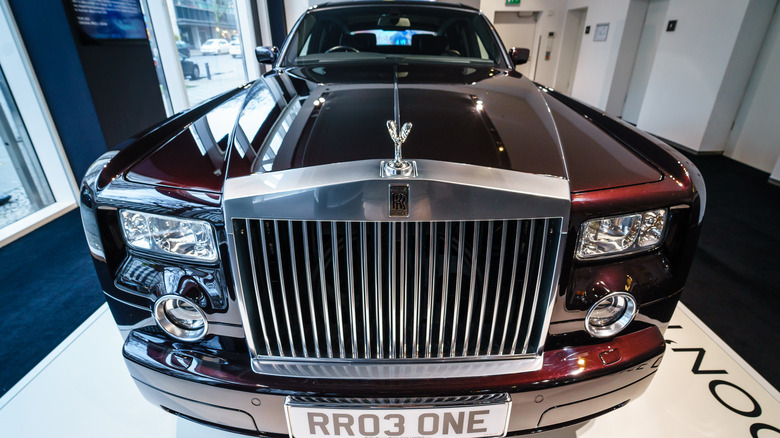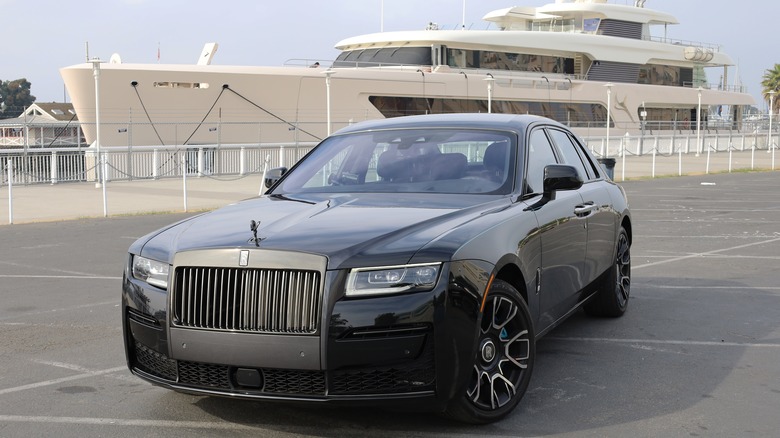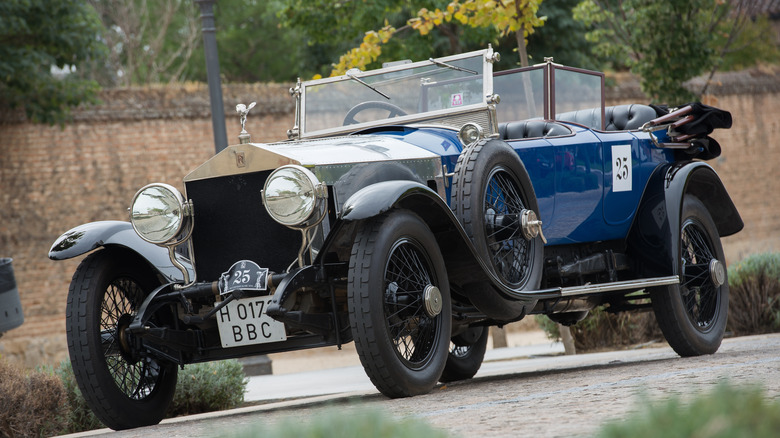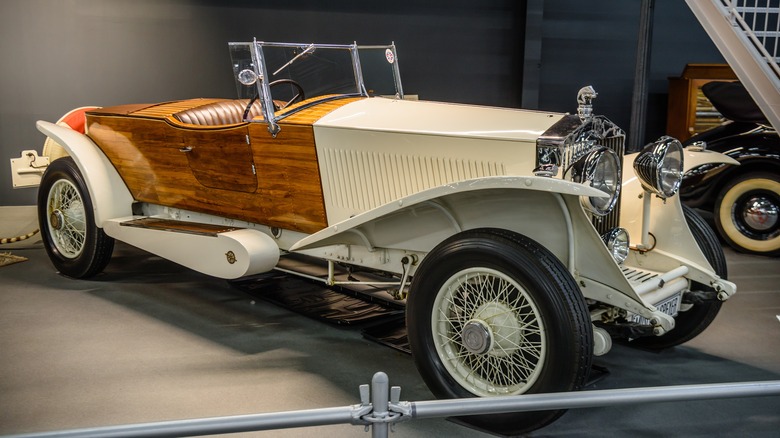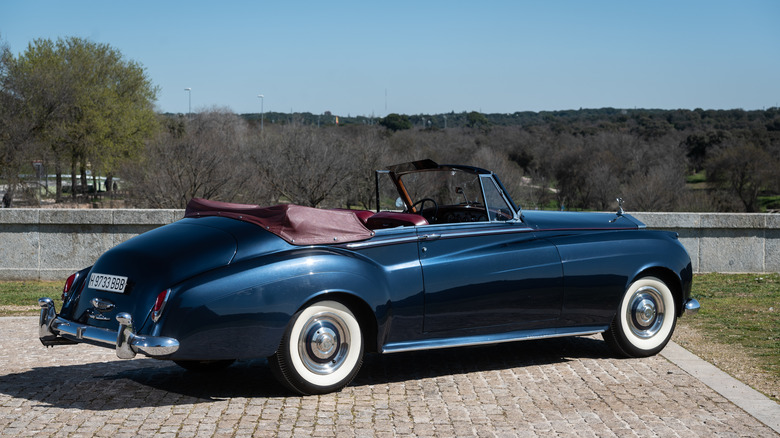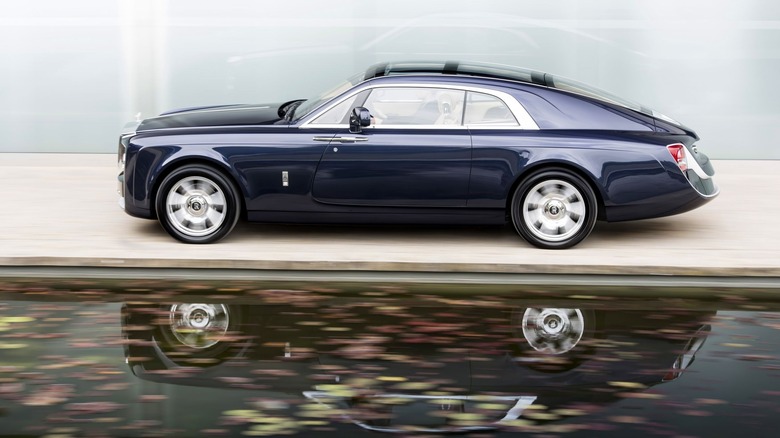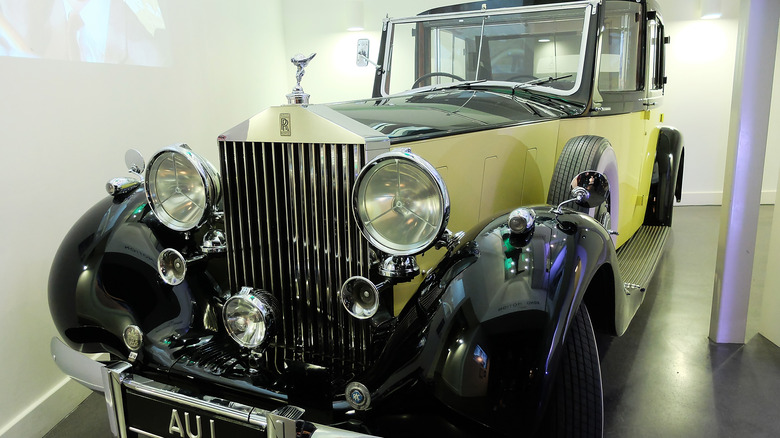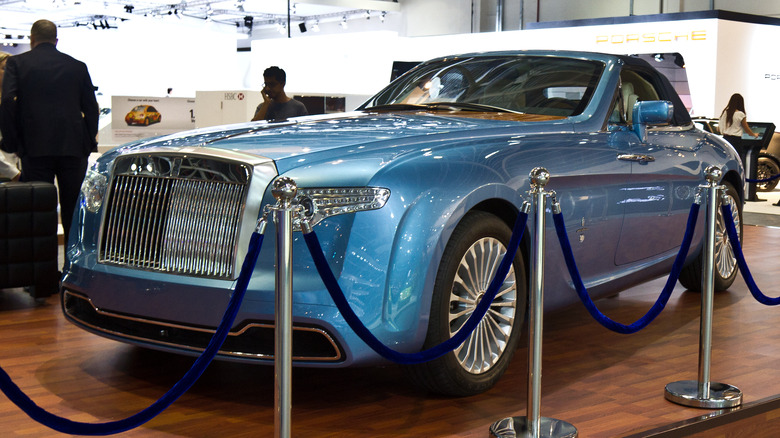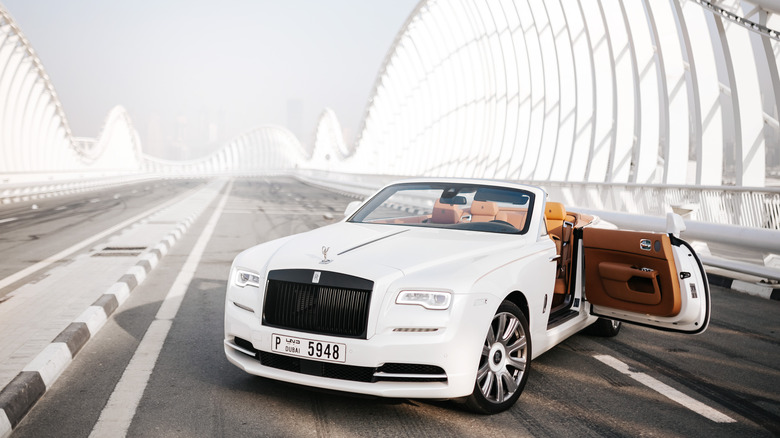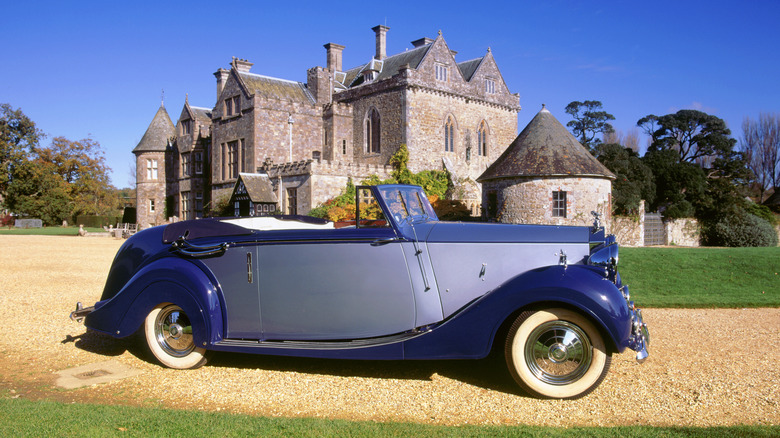The 15 Best Rolls-Royce Cars Of All Time
Rolls-Royce established itself as the benchmark for British automotive luxury at the opening of the 20th century. Henry Royce had already built the 1904 10 HP before he linked up with the auto seller Charles Rolls, and the two founded their company in 1906 to launch the six-cylinder Silver Ghost — soon to be hailed as "the best car in the world."
Since then, Rolls-Royce has survived world wars, economic cycles, and many changes in the manufacturing of and consumer preferences for automobiles. Yet it has always been known for large, luxurious, comfortable cars that seem to float silently across pavement. A few elements remain unchanged: the "Pantheon" grille, the double-R Rolls-Royce badge, and the Spirit of Ecstasy hood ornament that ranks among the most iconic bonnet tops of all time.
Part of the Rolls-Royce trade-off, aside from astronomical prices, is extremely heavy cars with poor gas mileage. No amount of opulence would be sacrificed in the name of lower curb weight. Perhaps it's no surprise, then, that Rolls-Royce is transitioning to an extremely heavy lineup of electric cars by 2030. Charles Rolls predicted that EVs were inevitable in 1900 because they are "perfectly noiseless and clean" with "no smell or vibration." While most gearheads prepare to gawk at, but not purchase, the Rolls-Royce Spectre EV in 2023, here are the 15 best Rolls-Royces so far.
Phantom VII
After its acquisition by BMW in 1998, Rolls-Royce came out firing on 12 cylinders with the 6.75-liter V12 Phantom VII 4-door sedan in 2003 — the first double R developed under BMW ownership. The venerable Phantom VII stayed in production for 14 years, including a Series II update in 2013, before the Phantom VIII followed in 2018. Near the end of its run, the Phantom VII reached gargantuan proportions in horsepower (453), size, and price. The 2016 Series II Phantom VII started at more than $417,000 and measured 19.1 feet in length, with an even longer extended wheel-base version available, according to Business Insider.
This monument to unparalleled luxury keeps alive many Rolls-Royce traditions, such as the large, ostentatious grille, backseat "suicide" doors that hinge at the rear and store umbrellas in drying compartments, and isolating backseat window curtains. However, the Phantom VII also looks like a sleek, modern vehicle, and its technological flourishes go beyond the BMW iDrive infotainment system. The hood ornament includes a spotlight and can be electronically lowered to conceal itself. The adaptive LED headlights can supposedly curve light beams around corners, and the floating Rolls-Royce logo embedded into the wheels stays upright while the wheels rotate. Included in the stately interior is a clock with a rotating bezel for telling the hour in many countries at a time.
Rolls-Royce added a Drophead Coupe (convertible) and Coupe bodies to the offering, but resale prices have not held up; they average about $140,000 today.
2022 Ghost Black Badge
When a nearly $400,000 stock Ghost simply won't do, the 2022 Black Badge Ghost steps in with a next-level interior featuring a laser-etched starry night roof lining to match the whimsical feel of its "magic carpet ride" air-suspension handling. While the Phantom VII harkened to a bygone era of landed gentry being chauffeured around the countryside in a luxury car centered on the passenger experience, the Ghost is all about the driving experience. The very hefty 5,500-pound V12 sedan zips into 60 mph in only 4.5 seconds, thanks to 563 horsepower and 627 lb-ft of torque. Yet its cornering and braking feel very poised as well, more so than with the typical Rolls-Royce.
The added $44K for the Black Badge styling goes toward enhanced interior materials from Technical Fibre, hand-inlaid infinity symbols, and still more infinity symbols as part of the interior's Illuminated Fascia on the dashboard. One also has the Bespoke option of choosing customized colors for the exterior, interior leather, trim, and so on.
Silver Ghost
Following on the heels of Rolls-Royce's first several cars, the six-cylinder Silver Ghost established the company's one-model policy and became an object of desire for the rich and famous, staying in production from 1907 to 1926 and selling around 8,000 total units. The Silver Ghost greatly contributed to Rolls-Royce's reputation for luxury comfort, but also established a reputation for performance. Around four years into its run, the motor carriage garnered the nickname of the Silver Ghost London-to-Edinburgh sport-tourer after finishing the 800-mile round trip between cities in top gear. In 2017, a chassis 2380 40/50 horsepower model of the 1913 Silver Ghost London-to-Edinburgh sport-tourer, which had been a part of The Henry Ford (museum) in Detroit and had been mechanically restored, sold at auction for just over $1 million dollars after fees.
That's quite an inflationary spike over the $13,450 that a young Howard Hughes paid for a new 1925 Silver Ghost Piccadilly Roadster — although at the time, Hemmings writes, that would have been at least enough money to purchase three Cadillac roadsters. By then the Silver Ghost's sizable engine could muster up as much as 85 horsepower. Hughes' Silver Ghost came out of the Springfield, Massachusetts plant that Rolls-Royce operated from 1920 to 1931, when the Great Depression limited who could afford what was commonly considered the greatest car in the world.
Phantom I/Phantom II
Perhaps the best known series in all of Rolls-Royce lore, the Phantom phenomenon launched in 1925 with the Phantom I (aka 40/50 Phantom), which sold about 3,500 units over four years. It continued with the Phantom II from 1929 to 1936, whose sales the Depression effected, and fewer than 2,000 were built. The Phantom II adds rear-axle springs and a more powerful engine output. Despite the redesigned chassis that lowers the Phantom II's height, the two cars share an unmistakable appearance with their elongated bonnets, yet also can be found in a diverse variety of some of the most impressive coachwork of the time.
Those irresistible looks and some nostalgia for perhaps the peak era of Rolls-Royce-as-status-symbol have helped make the first two Phantom iterations classic icons from dozens of movie and television appearances. Just a couple of examples include the 1928 Phantom I Ascot Dual Cowl Sport Phaeton that transported the main character of Francis Ford Coppola's 1974 "The Great Gatsby," and the animated Phantom II that appeared in the spy-spoof series "Archer."
Silver Cloud
The 1955 Silver Cloud, which replaced the Silver Dawn, was Rolls-Royce's first real post-war design. It was also the company's final car to feature body-on-frame construction, and had a similar look to the 1955 Bentley S Standard Saloon. Unusual for many preceding Rolls-Royce autos, the Silver Cloud was known to be pleasant to drive and also is more amenable to DIY repair and maintenance. Their value has held up over time more so than many other Rolls-Royces because most of its mechanical parts are available.
The automaker produced just under 8,000 Silver Clouds in all, spread across the Silver Cloud I (1955-1958), Silver Cloud II (1959-1962), and Silver Cloud III (1962-1965). By 1958, factory specs listed the 4.9-liter straight-six Silver Cloud I as topping 100mph for the first time, but the next year's Silver Cloud II, stepped with Rolls-Royce's first V-8 engine, could reach 113 mph. For their final iteration, Silver Cloud III cars stand out for their quad headlamps, and some even included air conditioning and power windows, rarities for their time.
Sweptail
There's nothing like an immaculate one-off Rolls-Royce to turn overly cool gearheads into starry-eyed, slack-jawed kids. Inspired by racing yachts, the one-off 2017 Sweptail coupe features a panoramic glass roof and the largest Pantheon grille of any modern Rolls-Royce, milled from solid aluminum and hand polished to a reflective sheen. The bespoke beauty took designers and engineers several years to satisfy the unnamed buyer's desire for a coachbuilt Rolls with modern panache but hints at the golden days of the 1920s and '30s. The buyer wanted a two-seat coupe with a panoramic glass roof. Said glass tapers at the rear along with the rest of the body to form a nautical-style stern shape.
The beautifully polished and minimalistic interior "equates elegance with simplicity," in the automaker's words. It includes such unique elements as a luggage shelf with an illuminated glass rim, a full set of Rolls-Royce Bespoke luggage, and matching dual attache cases that appear at the press of a button. Final details like the champagne-chilling center console complete with crystal flutes make one wonder at the surely astonishing price commanded for the Sweptail.
Phantom III
The third in the Phantom line replaced the Phantom II in 1936. The Phantom III was the last of the very large pre-WWII Rolls-Royce vehicles; they still retained the boxy aesthetic feel of early 20th-century Rolls-Royce autos, before post-war models became smaller and stylistically sleeker. From 1936 to 1939, 727 Phantom IIIs were made.
Perhaps the most famous of those is the iconic custom 1937 black and yellow Phantom III Sedanca de Ville that the namesake villain of the 1964 James Bond film Goldfinger drove. The car's origin speaks to the typically upper-crust nature of old-world Rolls-Royce luxury vehicles. The Chassis #3BU168 was custom-made by Coachbuilder Barker for Lord Fairhaven of Anglesey Abbey, Cambridgeshire, England in 1937, according to Bond Lifestyle.
The Phantom III sports the first V12 Rolls-Royce engine, which would be the only V12 for the company until the 1998 Silver Seraph that employed a BMW M73 V12, 5.4-liter engine.
Twenty
Although the Twenty (produced 1922-1929) was smaller and less expensive than the Silver Ghost and the Phantom I, it's styling and elegance have stood as a quintessential look of Roaring Twenties motoring. The Twenty was actually the smallest car Rolls Royce would ever make, and while that move supposedly came from consumer demand for something smaller, British reception for the car called it "Americanized" for its size, its original use of a three-speed gearbox, and other reasons that the company later corrected. It eventually became a decent seller, with more than 2,800 chassis made during its run. It didn't hurt that the Twenty cost a fraction of most other R-R cars: about $1,975 compared to the average of $12,000 for a Rolls-Royce in 1920.
The rear-wheel drive Twenty put out a maximum of 50 horsepower from its spark-ignition 4-stroke engine, according to Automobile Catalog, and reached a top speed of 65 mph.
Phantom Drophead Coupe
This two-door, four-seat, convertible version of the 2007 Phantom VII is a hulking masterpiece trimmed with exquisite wood, leather, and chrome. A single unit of the Phantom Drophead Coupe requires 350 worker hours before it's finished, via Motor Trend. Laborious effort goes into, for example, the dozens of pieces of open-pore teak for the interior — sourced from a single tree and oiled to keep their color. Other opulent options such as stainless steel metalwork, two-tone paint, or extra mohair and chrome would add on to the price of over $400,000.
The Phantom Drophead Coupe is drop-dead gorgeous, but also powerful; its 6.8-liter V12 engine delivers 453 horsepower for an exhilarating, yet buttery smooth ride thanks to its pampering air suspension system and six-speed automatic transmission. The Phantom Drophead Coupe includes BMW's iDrive system, side LED lights, active rollover protection, and a parking/pullout assistive camera hidden in the nose of the vehicle.
25/30
The 1936-1938 6-cylinder 25/30 followed the 20/25 (1929-1936) in the Rolls-Royce timeline. When it came to prestige, both models took a back seat so to speak to the Phantom II and V12 Phantom III, which were produced concurrently. However, the 25/30 is still considered a classic car of the Depression Era, chosen to represent elegant luxury cars of that time in films such as the original 1978 version of "Death on the Nile."
A 25/30 found for sale at a car show in 2018 represented the model with a 4,257-cc straight-six engine of approximately 115 HP and a four-speed manual transmission, according to Hemmings. This car comes from the coachbuilt era, and its long wheelbase, enclosed limousine chassis London's Hooper & Co. Coachbuilders had enough seating for six or seven people with its fold-down rear seats.
Hyperion
When an already elegant piece of automotive sculpture lands in the lap of meticulous design experts bent on winning prestigious international competitions, we get something like the 2008 Rolls-Royce Pininfarina Hyperion. Italian car-design firm Pininfarina designed the one-off custom Hyperion based on a Phantom Drophead Coupe. It debuted at the ultra-swank Pebble Beach, California Concours d'Elegance in late 2007, per Supercars.net. Collector Roland Hall tasked Pininfarina with building a one-off version of the Drophead Coupe that stood alone as a piece of art hinting at the lines and dimensions of classic cars from the 1930s to the 50s, and with flare not possible using mass production.
For example, Pininfarina created a new folding hood, which when down stays under a custom teak wood-lined cover. The same wood styling, inspired by luxury boating components, contributes to the dual storage compartments in front of the windshield. Pininfarina's Special Projects Division contracted several reputed firms to handle other bespoke touches, such as the gorgeous carbon fiber bodywork, the glazed surfaces, wheel rims, and the teak wood finishes.
The designers moved the driver's position back more than a foot, removed the back seat, lengthened the roof, and shortened the rear. Other tweaks, like the inclined grille, more aerodynamic windshield, and tailed end create a sense of forward momentum, but the overall impression is that of awe.
Dawn
In 1997, the sun set on the Rolls-Royce's second version of the Silver Dawn luxury car ahead of the transfer of ownership to BMW. But in 2016, a new Dawn arose in the sleek form of the 2017 Dawn convertible. It was really more of a replacement for the Phantom Drophead Coupe and the new standard for top-down luxury. The Dawn's design echoed the 2013 Wraith coupe, but with some noticeable modifications like a recessed grille and a jutted-forth bottom bumper to emphasize what the company calls the "jet air intake face."
The Dawn sports extra-long doors to allow better entry/exit for rear seats. Its four full-size bucket seats are also unusual. Even the back seats are made for adult-proportioned humans, because why waste the exquisite luxury on unappreciative children?
By this time a V12 was normal for a Rolls-Royce, and the Dawn's 6.6-liter twin-turbo engine with 563 horsepower and 575 lb-ft of torque revved from a standstill to 62 mph 4.9 seconds — not bad for a 5,644-pound car. Yet the Dawn still achieved nearly 20 mpg in combined city/highway fuel efficiency. Next-generation tech included a 16-speaker bespoke audio system, 10.25-inch HD display, rear camera views, radar cruise control, and GPS-connected gear changes that consider the road ahead. All that costed posh buyers $341,124 or almost $400K with just a small number of options.
Silver Wraith
The Silver Wraith debuted in 1946 as a smaller redesign of the Wraith, its reduced size reflecting the post-WWII national mood in the United Kingdom. The Silver Wraith was Rolls-Royce's final all-coachbuilt car. Higher profits from the factory-built Silver Dawn in 1949 and Silver Cloud in 1955 indicated that they were the future, according to Hagerty. Still, the Silver Wraith stayed in production until 1959, selling 1,783 units, all of them with bodies made by various coach-builders. At various stages, it would come in drophead coupe, limousine, saloon, and Sedanca de Ville sub-models — via Automobile Catalog.
In general, the Silver Wraith was known for luxurious comfort during long-distance travel. Besides representing an increasingly rarer sense of custom-built elegance, the Silver Wraith continued to use other disappearing features, such as thermostatically controlled radiator shutters. It was also modernized during its production run with an optional automatic transmission in 1952 and power steering in 1956.
Silver Shadow
The Silver Shadow turned a corner for Rolls-Royce both in design and manufacturing. It was the first Rolls-Royce with a unibody design, and it was smaller and more rectangular than the more traditionally elegant Silver Cloud. However, the 200 horsepower V8 Silver Shadow was also faster, lighter, and had the best handling of any previous Rolls. Its engine ballooned to 6,750 cc compared to the Silver Cloud's 6,230 cc, and it included self-leveling rear suspension.
Hagerty notes that Rolls-Royce built 16,717 Silver Shadow standard steel saloons from 1965 to 1976. It was the "twin" of the Bentley T1, and in 1977 they were both replaced with the Silver Shadow II and Bentley T2. Those two sequels were basically the same cars but with rack-and-pinion steering and some other minor modifications. Although the Silver Shadow sold in large numbers, their repair costs began to exceed their total value, so they are not wildly popular on the resale market.
Corniche
Most units of the well-selling Rolls-Royce Silver Shadow were of the four-door variety, however, there were also two-door saloon and convertible sub-models. In 1971, those two-door Silver Shadows were renamed the Corniche. Most, however, were convertibles, as the rare fixedhead Corniche coupe only yielded about 1,100 cars from 1971 to 1981.
The first iteration of the Corniche brandished slight upgrades from the preceding Silver Shadow such as radial tires, ventilated front disc brakes, and noise-reducing front suspension bushings, according to Hemmings. The refined suspension and power steering served to polish what was already an impeccably silent and smooth ride that glided down motorways. Even when idling, a two-plane crankshaft served to balance out the Corniche. Under the hood, the 6.75-liter engine featured all-aluminum block and heads.
Externally, the Corniche style would become even cleaner and lighter on ornamentation — without sacrificing elegance — as their models progressed. The all-convertible Corniche II, Corniche III, and Corniche IV each enjoyed four-year runs from 1986 to 1995. However, nothing suggested the passage of time during the Corniche's long timeline quite so much as its price. Its sticker in 1972 read $39,500 (12 thousand more than the average American house at the time). In 2000, the Corniche (unofficially the Corniche V) resurfaced for a limited run of only 400 cars, and by the turn of the millennium, inflation and other factors drove its base price to $376,090, per Car and Driver.

